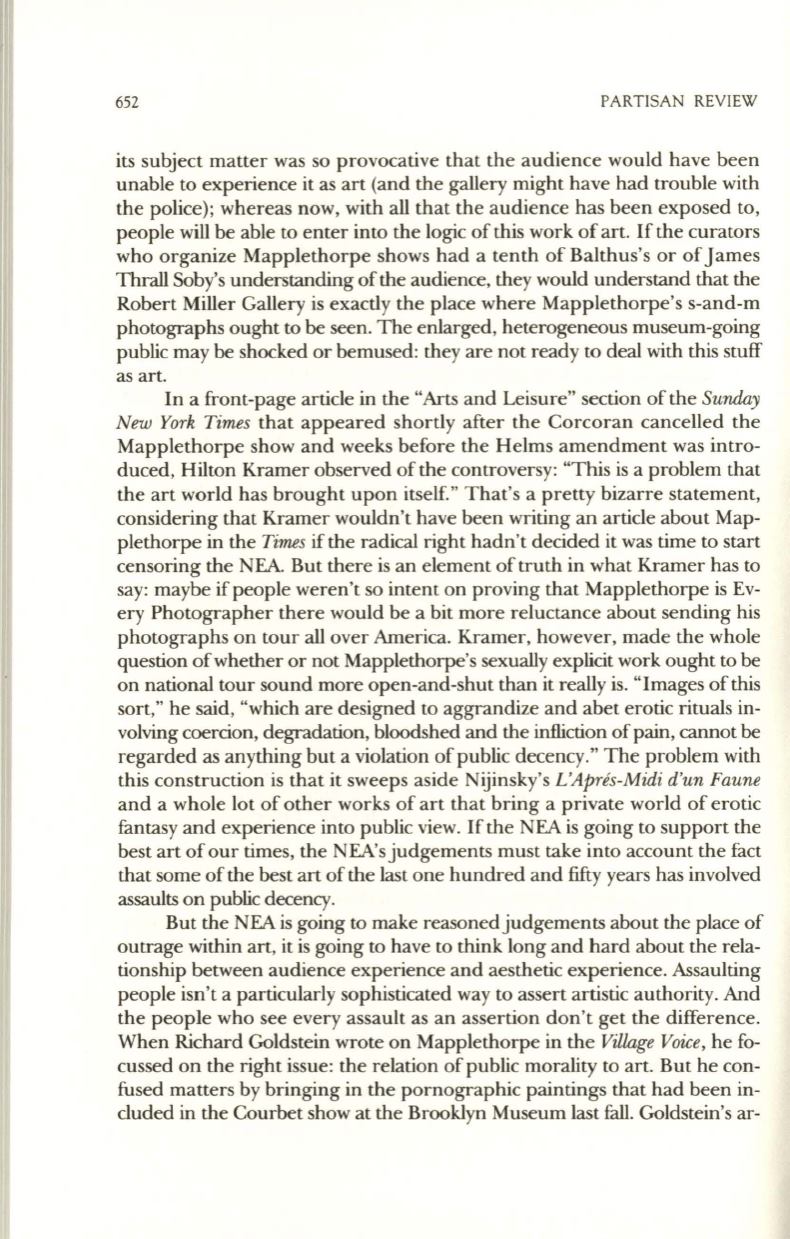
652
PARTISAN REVIEW
its subject matter was so provocative that the audience would have been
unable to experience it as art (and the gallery might have had trouble with
the police); whereas now, with all that the audience has been exposed to,
people will be able to enter into the logic of this work of art. If the curators
who organize Mapplethorpe shows had a tenth of Balthus's or of James
Thrall Sohy's understanding of the audience, they would understand that the
Robert Miller Gallery is exactly the place where Mapplethorpe's s-and-m
photographs ought to be seen. The enlarged, heterogeneous museum-going
public may be shocked or bemused: they are not ready to deal with this stuff
as art.
In a front-page article in the "Arts and Leisure" section of the
Sunday
New York Times
that appeared shortly after the Corcoran cancelled the
Mapplethorpe show and weeks before the Helms amendment was intro–
duced, Hilton Kramer observed of the controversy: "This is a problem that
the art world has brought upon itself." That's a pretty bizarre statement,
considering that Kramer wouldn't have been writing an article about Map–
plethorpe in the
Times
if the radical right hadn't decided it was time to start
censoring the NEA. But there is an element oftruth in what Kramer has to
say: maybe if people weren't so intent on proving that Mapplethorpe is Ev–
ery Photographer there would be a bit more reluctance about sending his
photographs on tour all over America. Kramer, however, made the whole
question ofwhether or not Mapplethorpe's sexually explicit work ought to be
on national tour sound more open-and-shut than it really is. "Images of this
sort," he said, "which are designed to aggrandize and abet erotic rituals in–
volving coercion, degradation, bloodshed and the infliction of pain, cannot be
regarded as anything but a violation of public decency." The problem with
this construction is that it sweeps aside Nijinsky's
L'Apres-Midi
d'un Faune
and a whole lot of other works of art that bring a private world of erotic
fantasy and experience into public view.
If
the NEA is going to support the
best art of our times, the NEA's judgements must take into account the fact
that some of the best art of the last one hundred and fifty years has involved
assaults on public decency.
But the NEA is going to make reasoned judgements about the place of
outrage within art, it is going to have to think long and hard about the rela–
tionship between audience experience and aesthetic experience. Assaulting
people isn't a particularly sophisticated way to assert artistic authority. And
the people who see every assault as an assertion don't get the difference.
When Richard Goldstein wrote on Mapplethorpe in the
Village Voice,
he fo–
cussed on the right issue: the relation of public morality to art. But he con–
fused matters by bringing in the pornographic paintings that had been in–
cluded in the Courbet show at the Brooklyn Museum last fall. Goldstein's ar-


